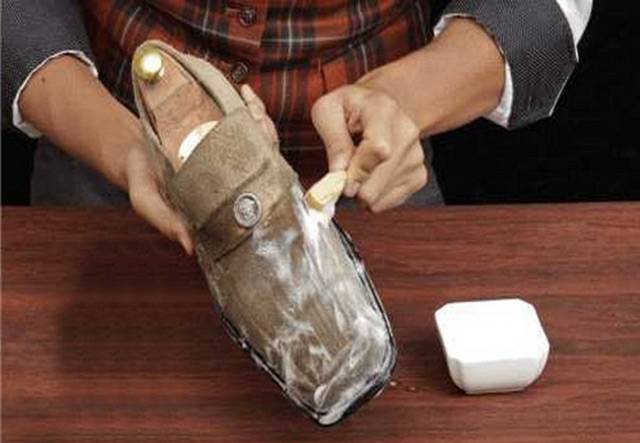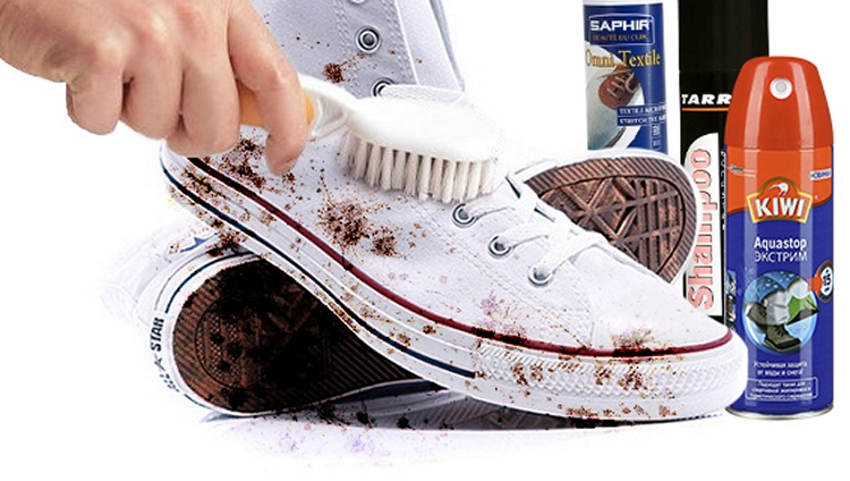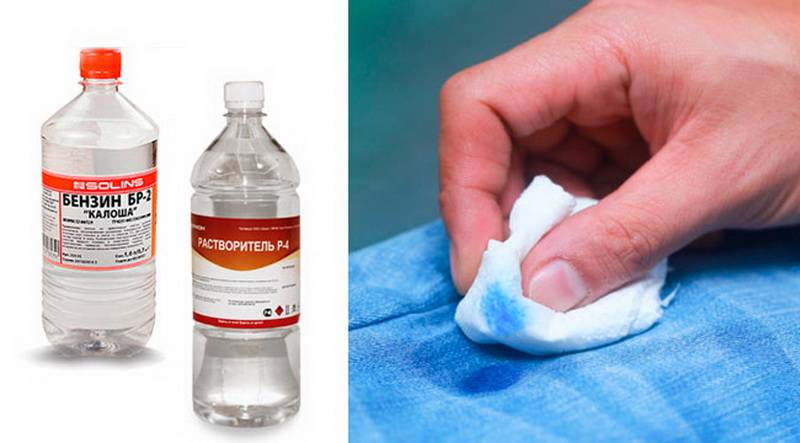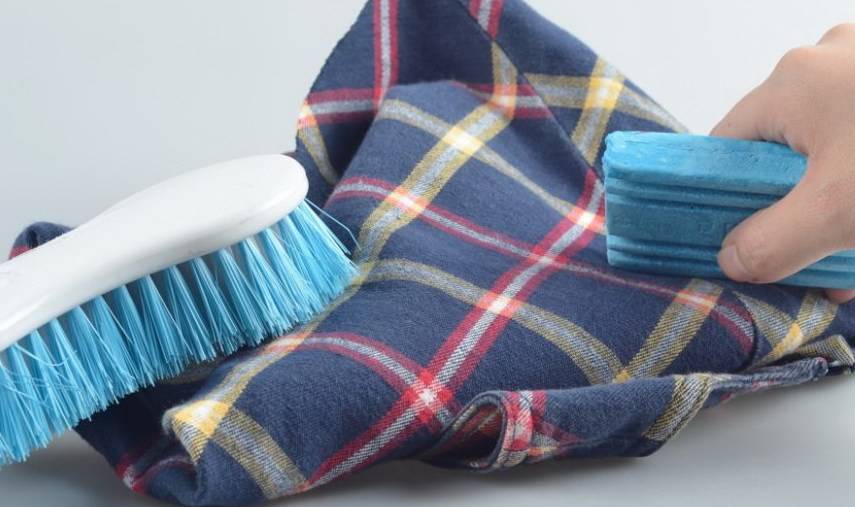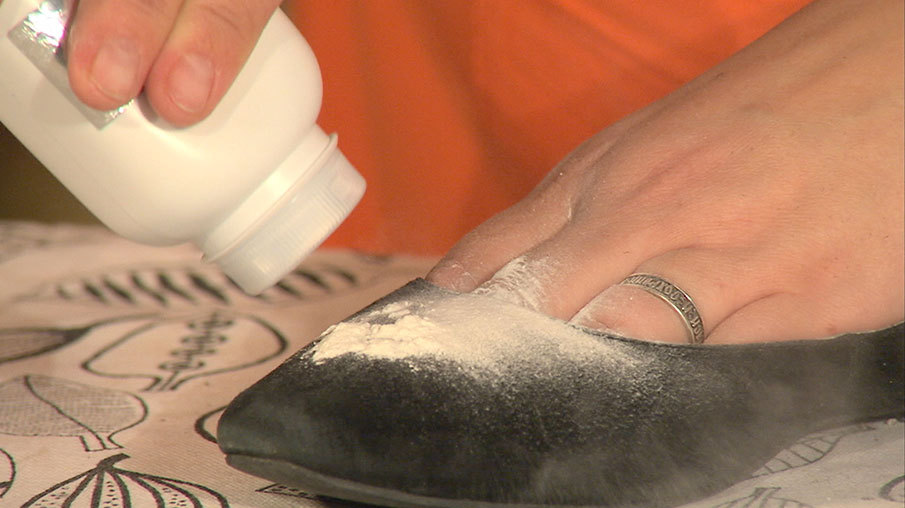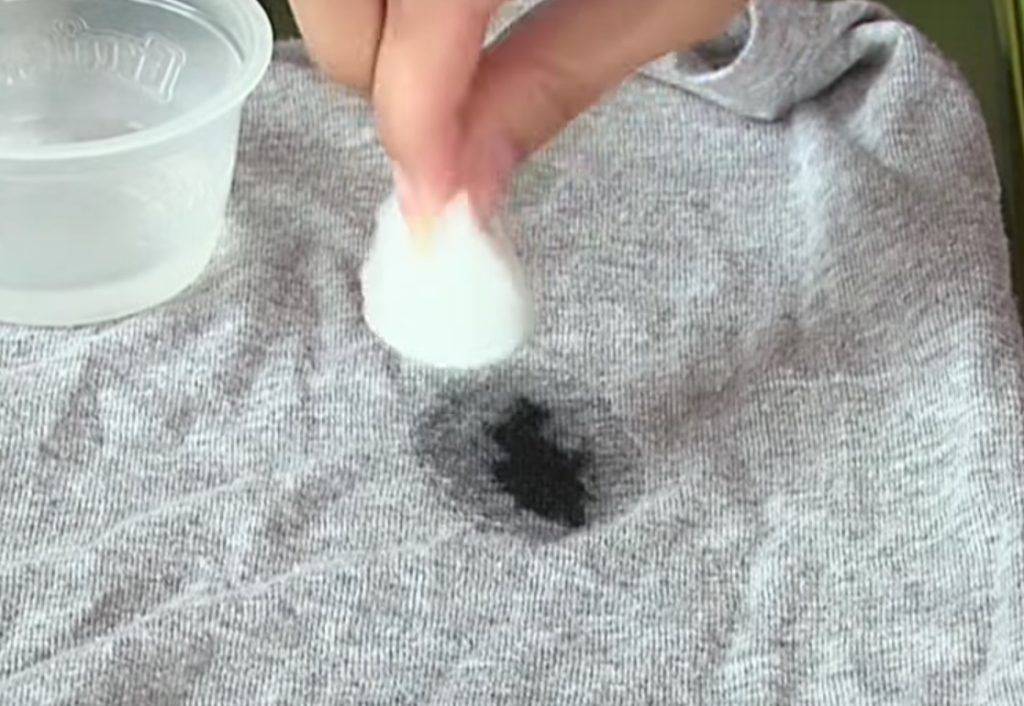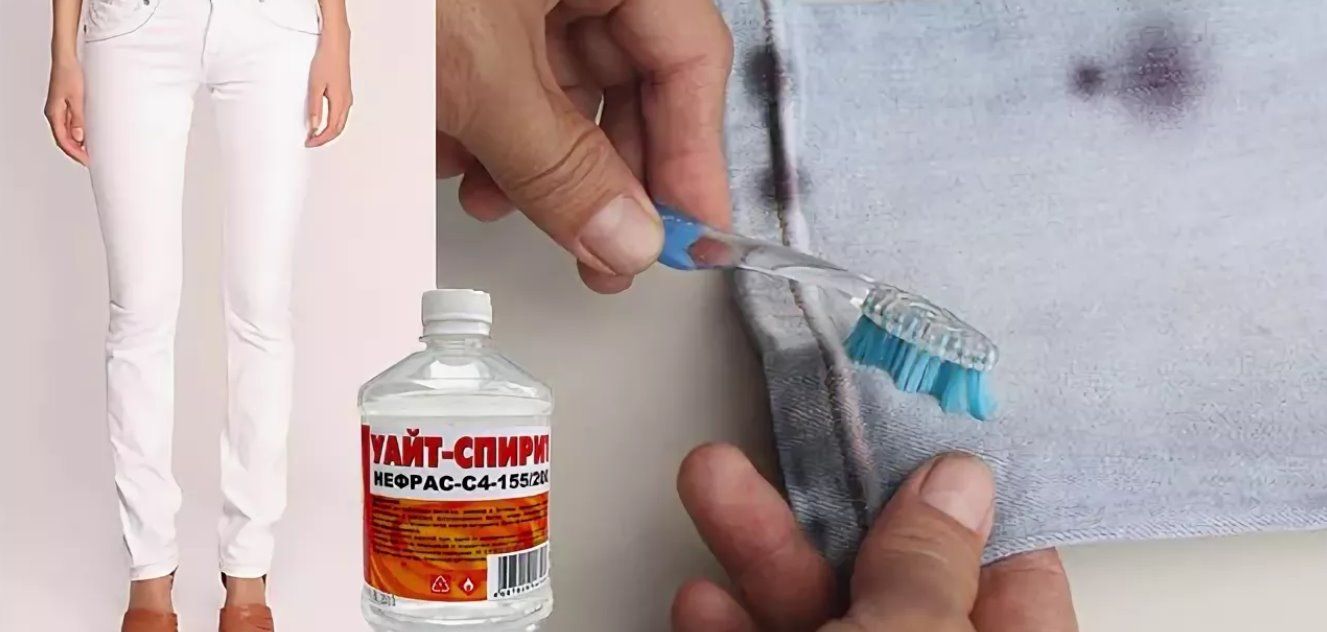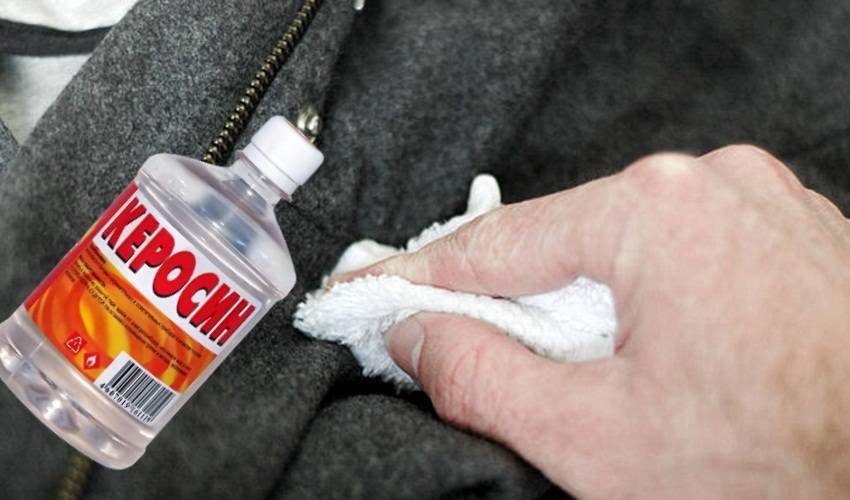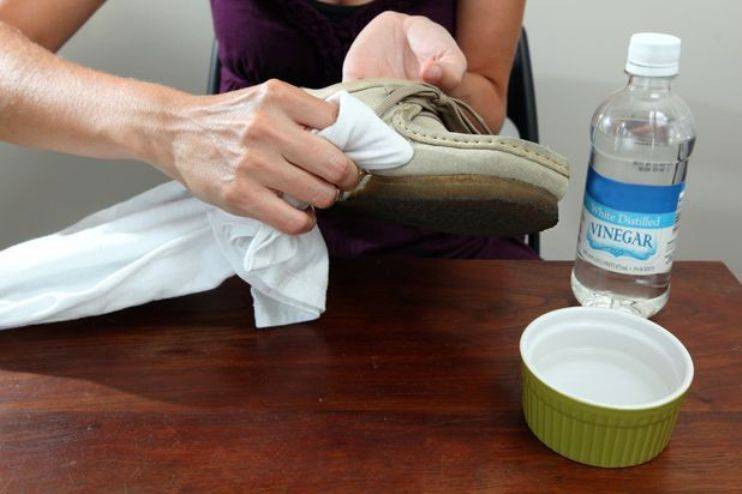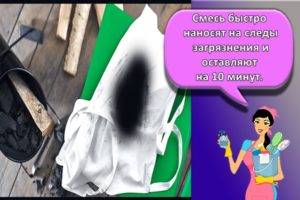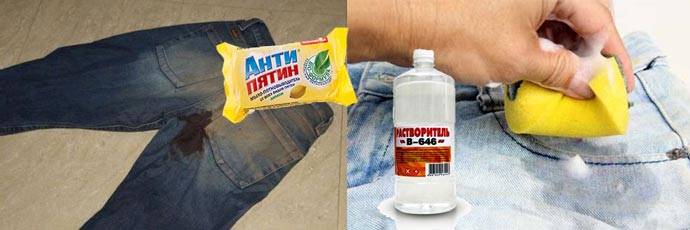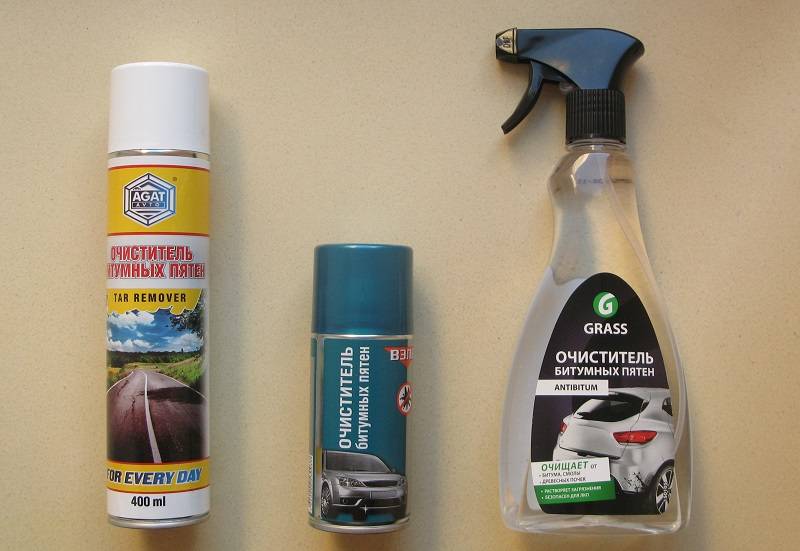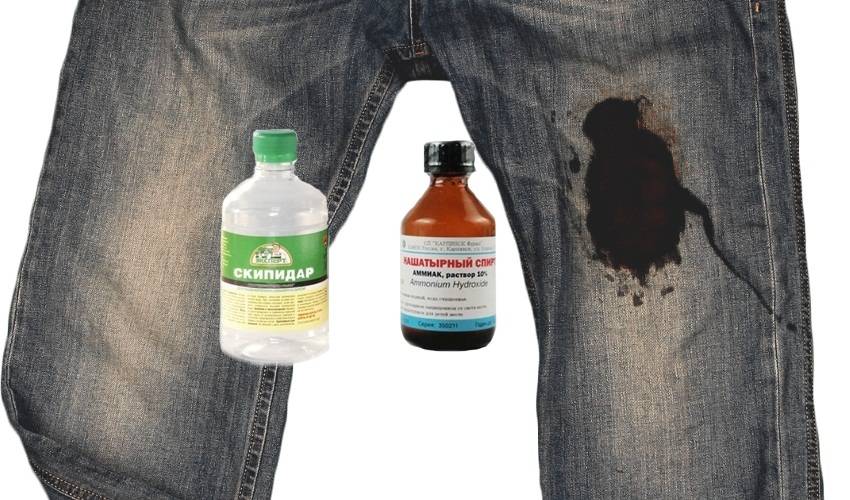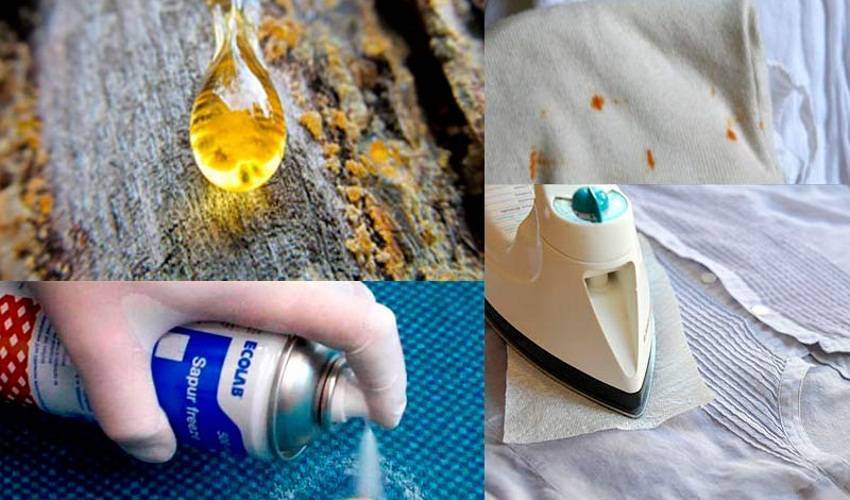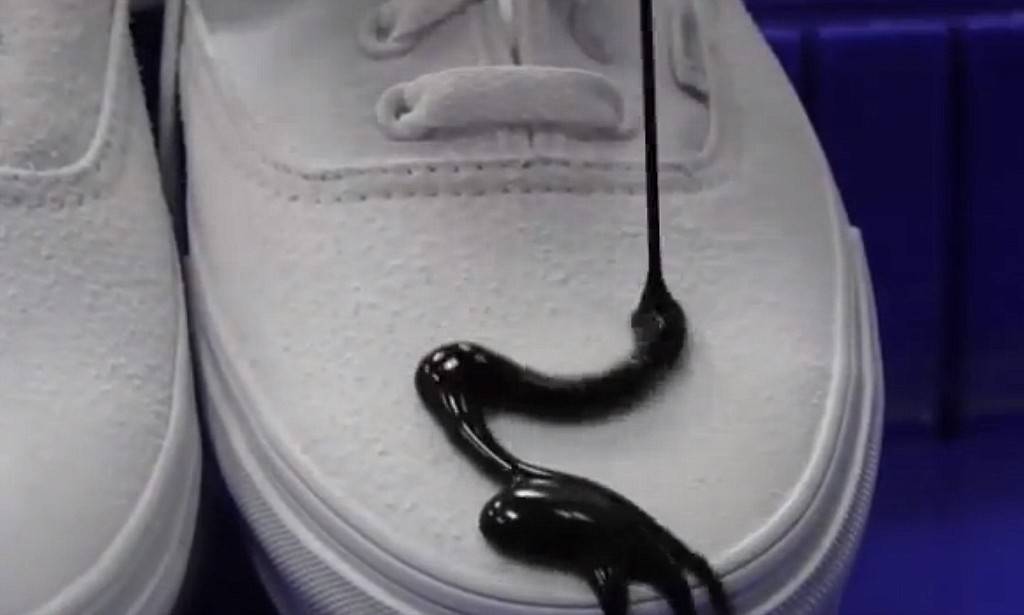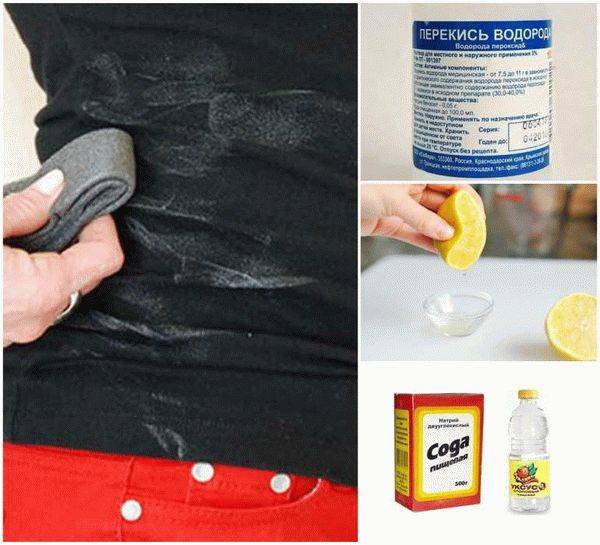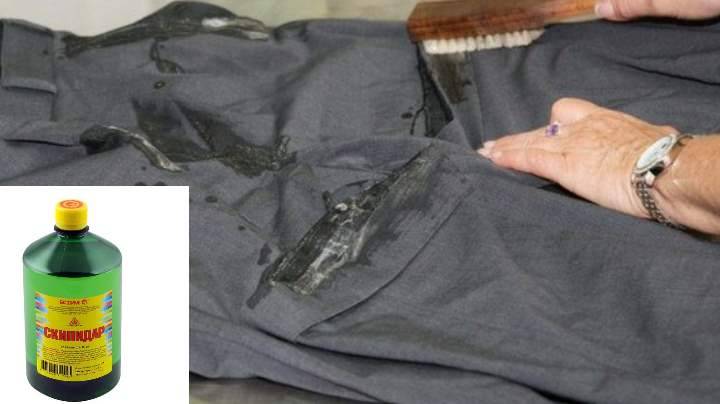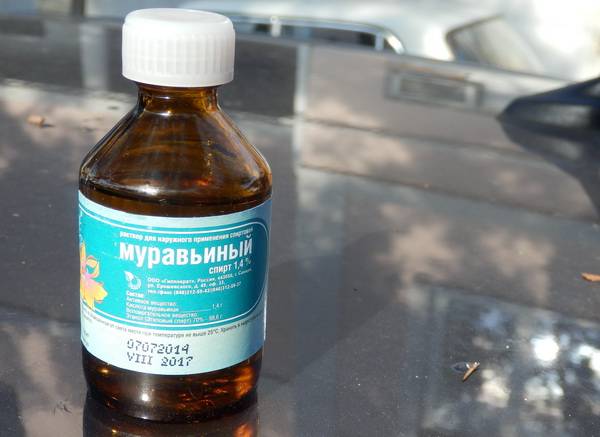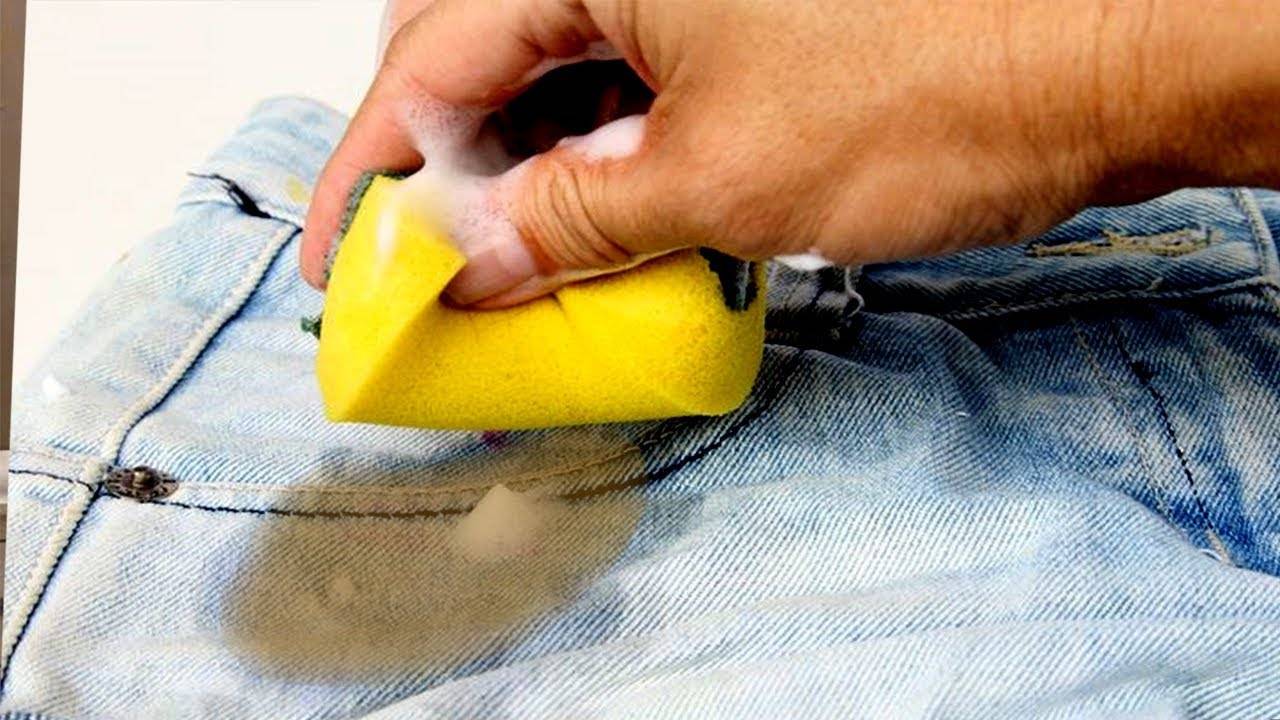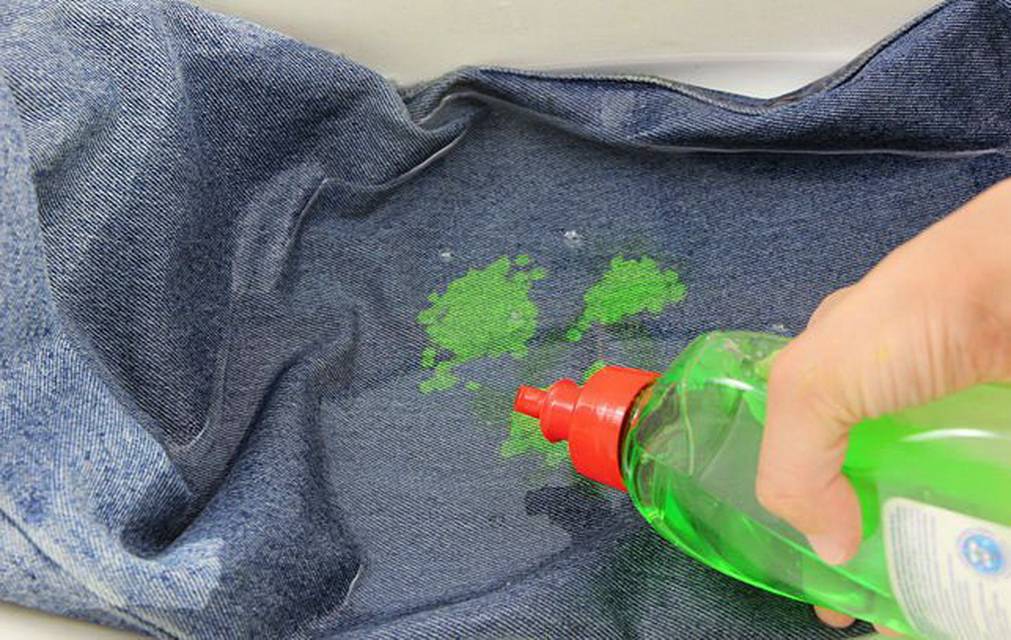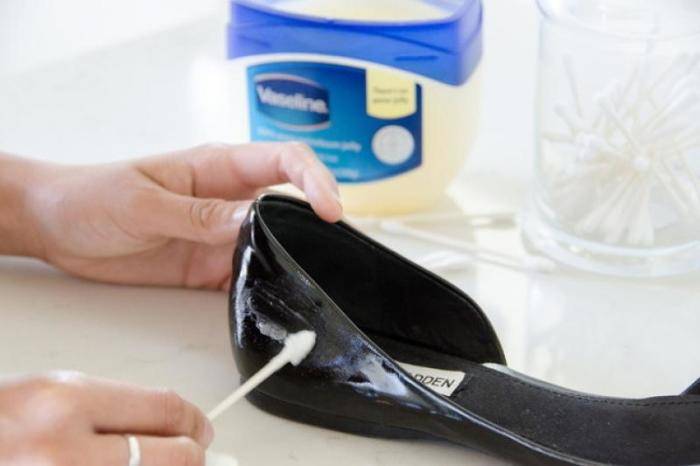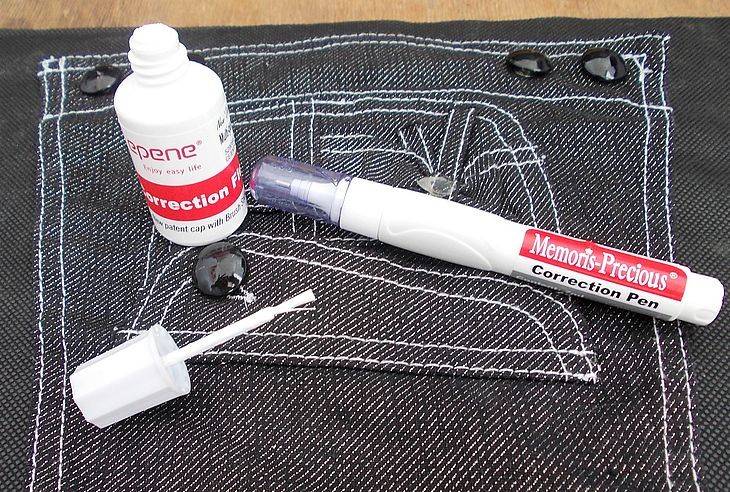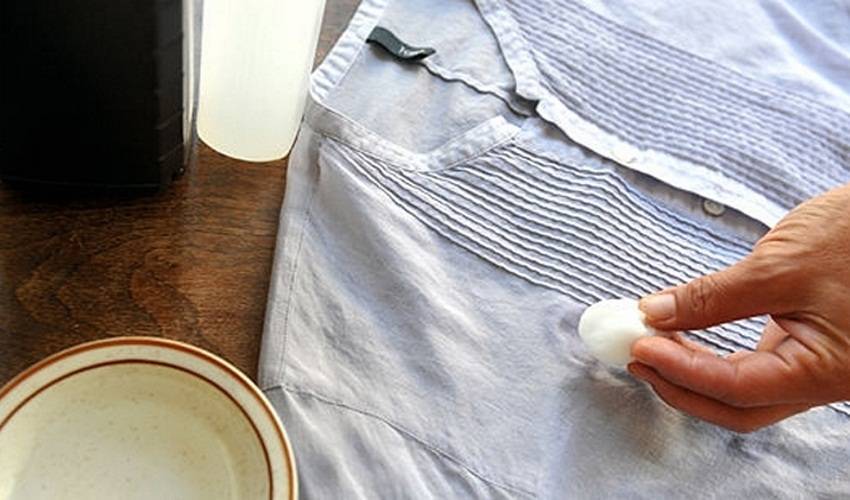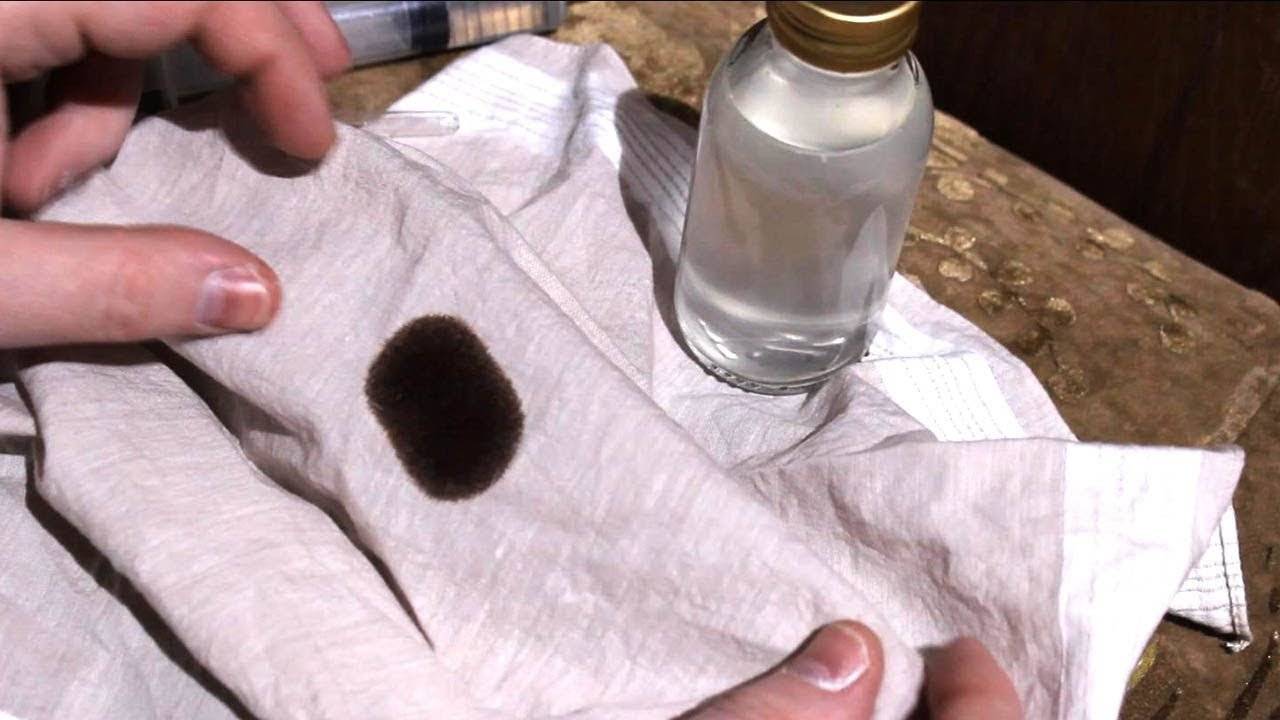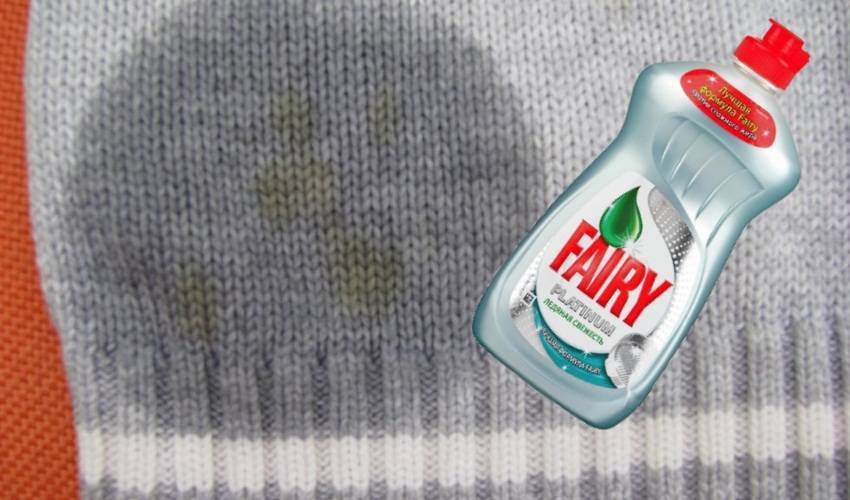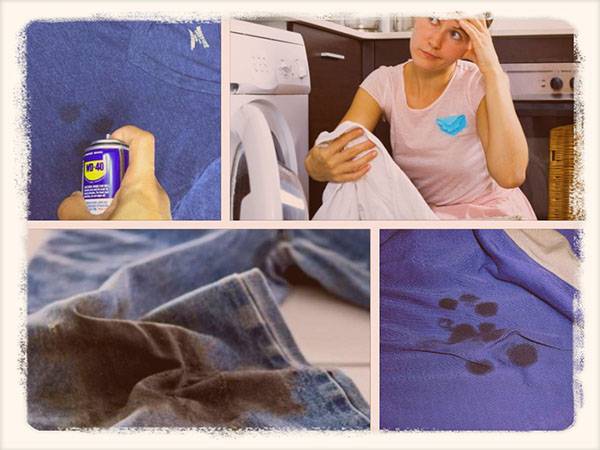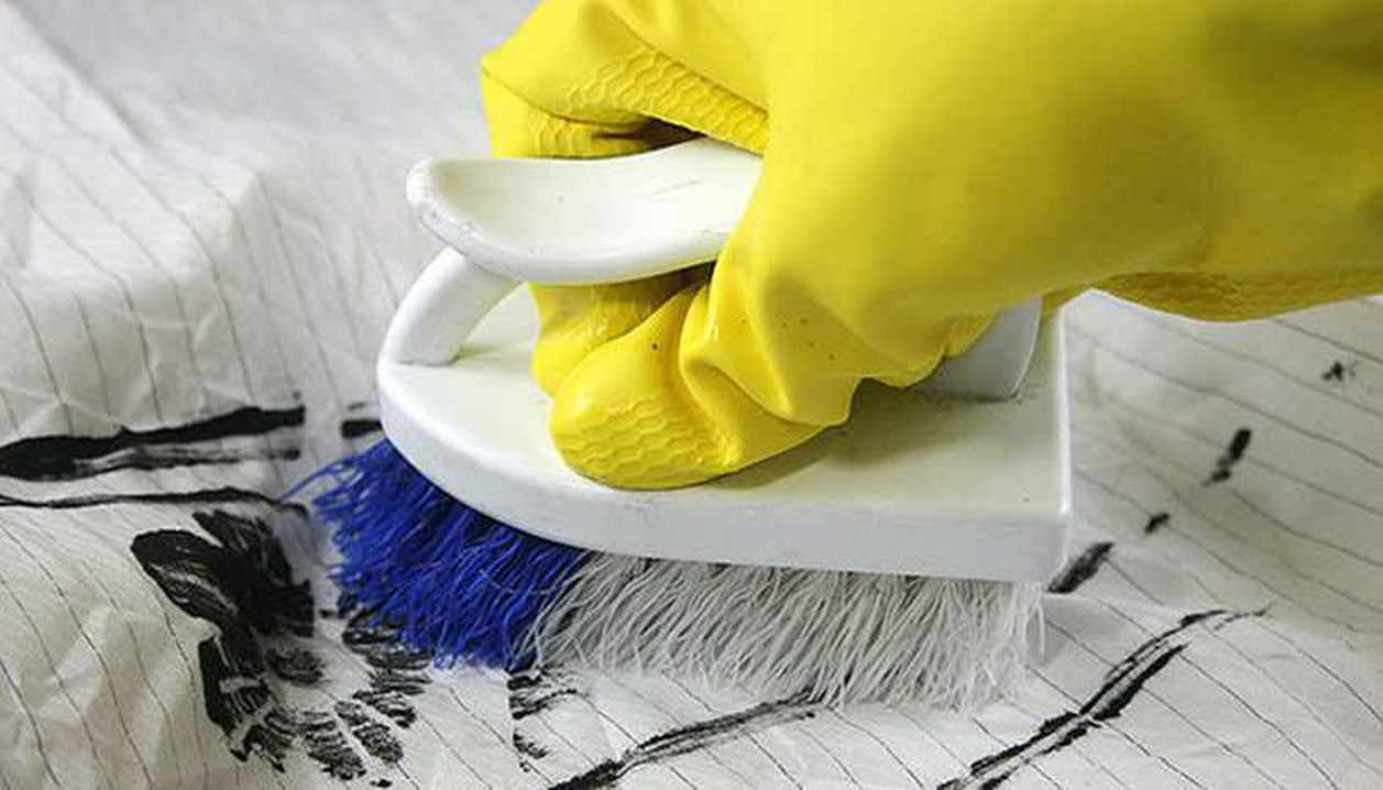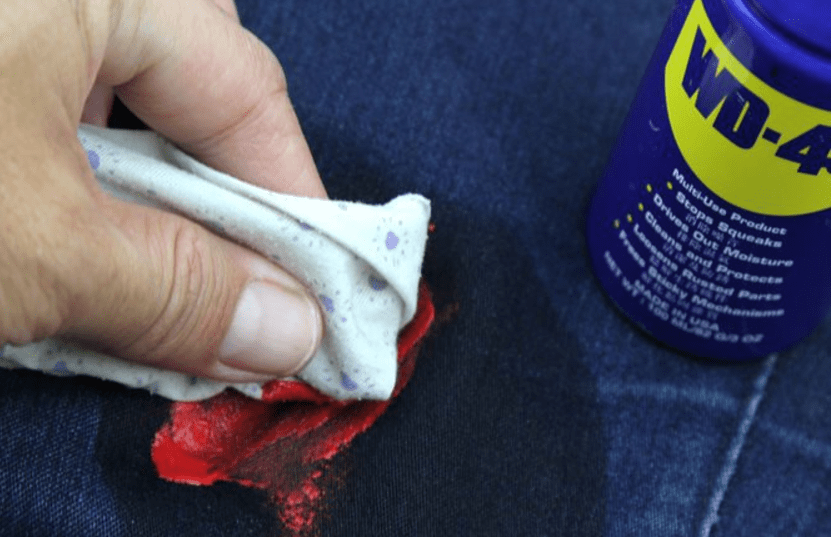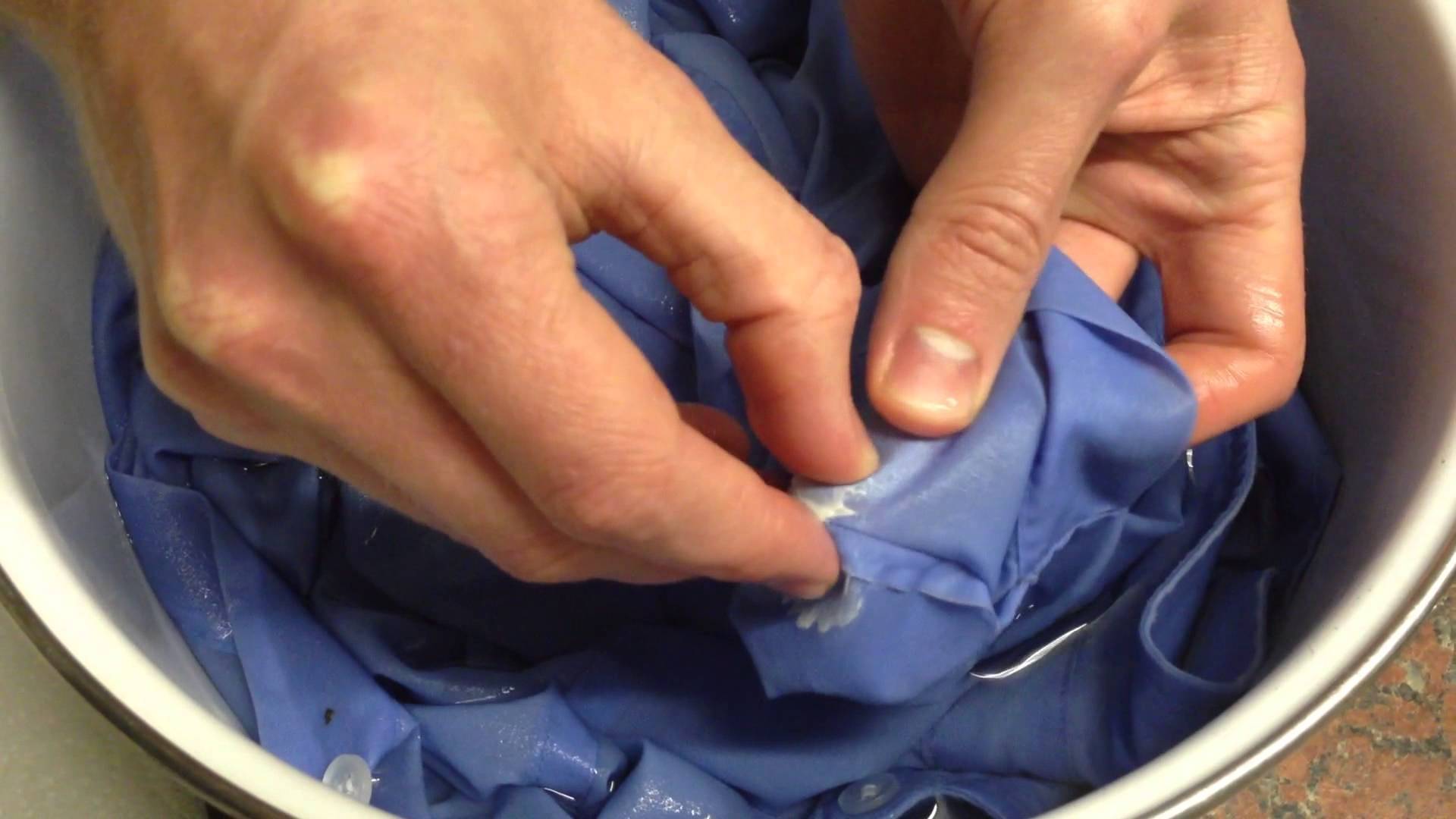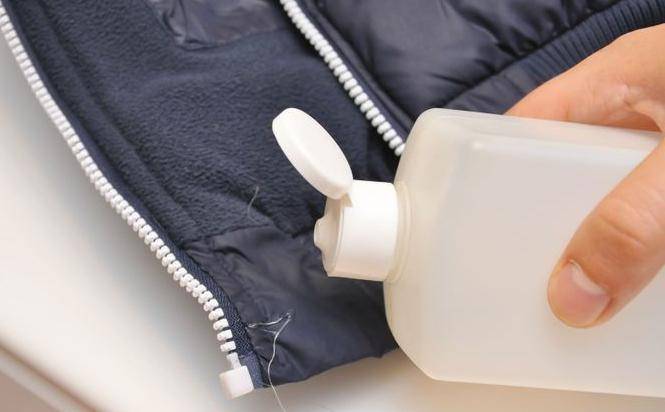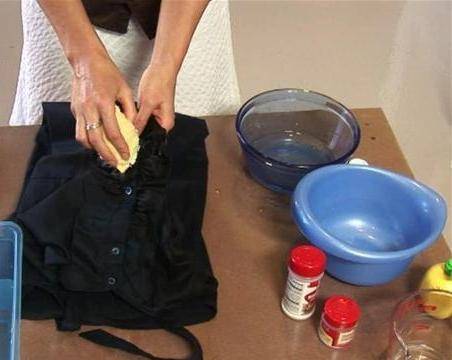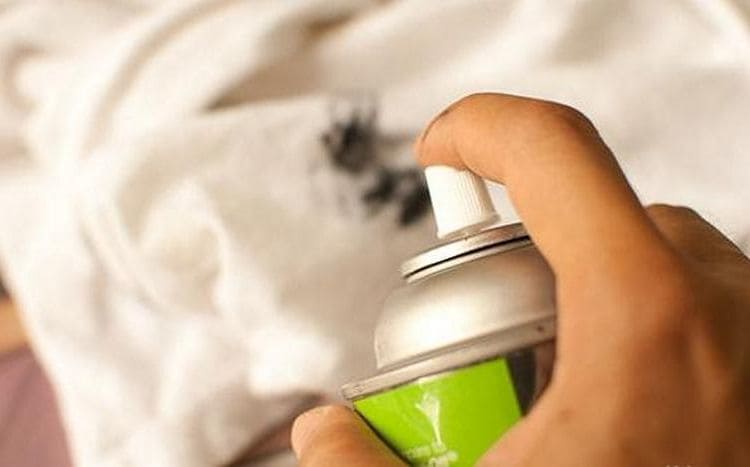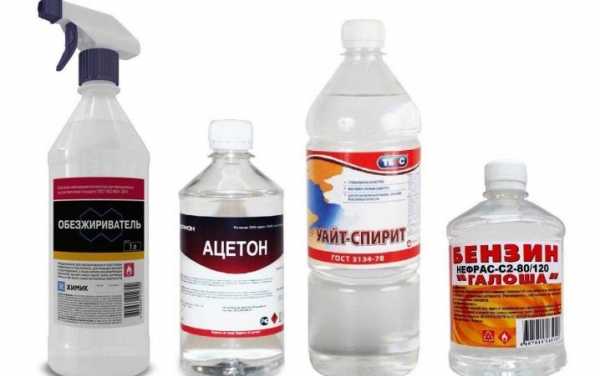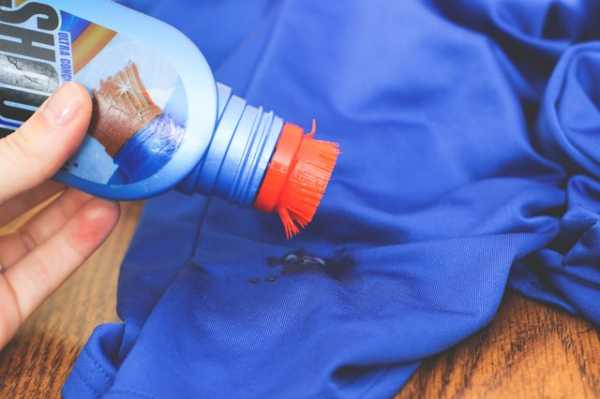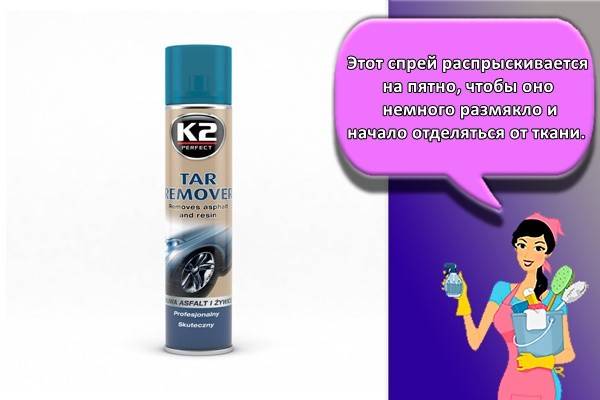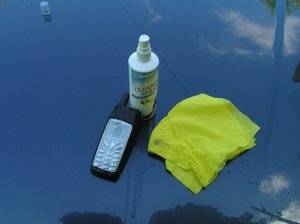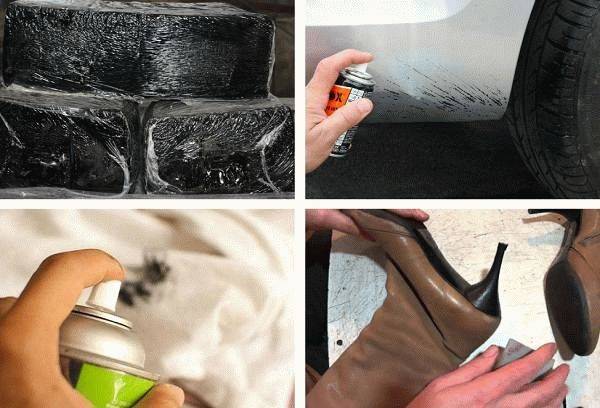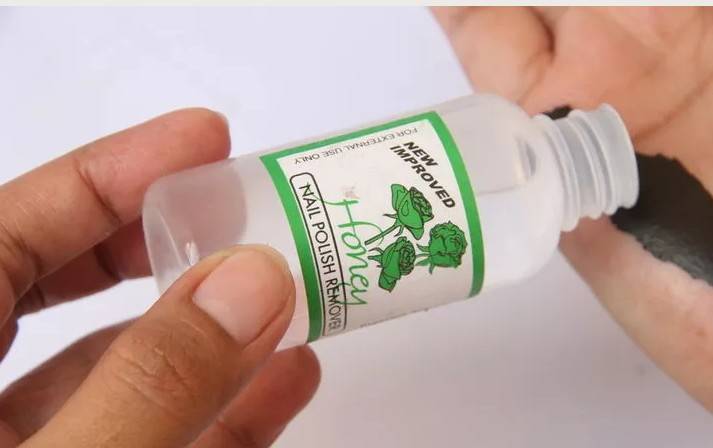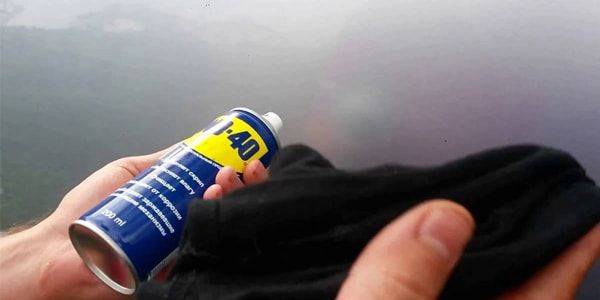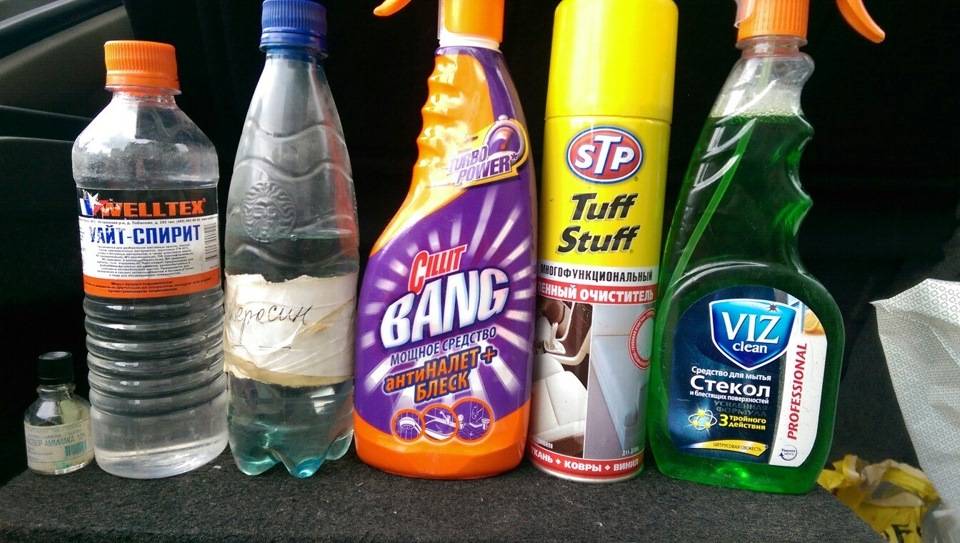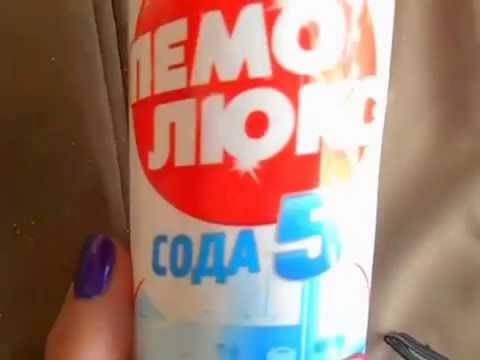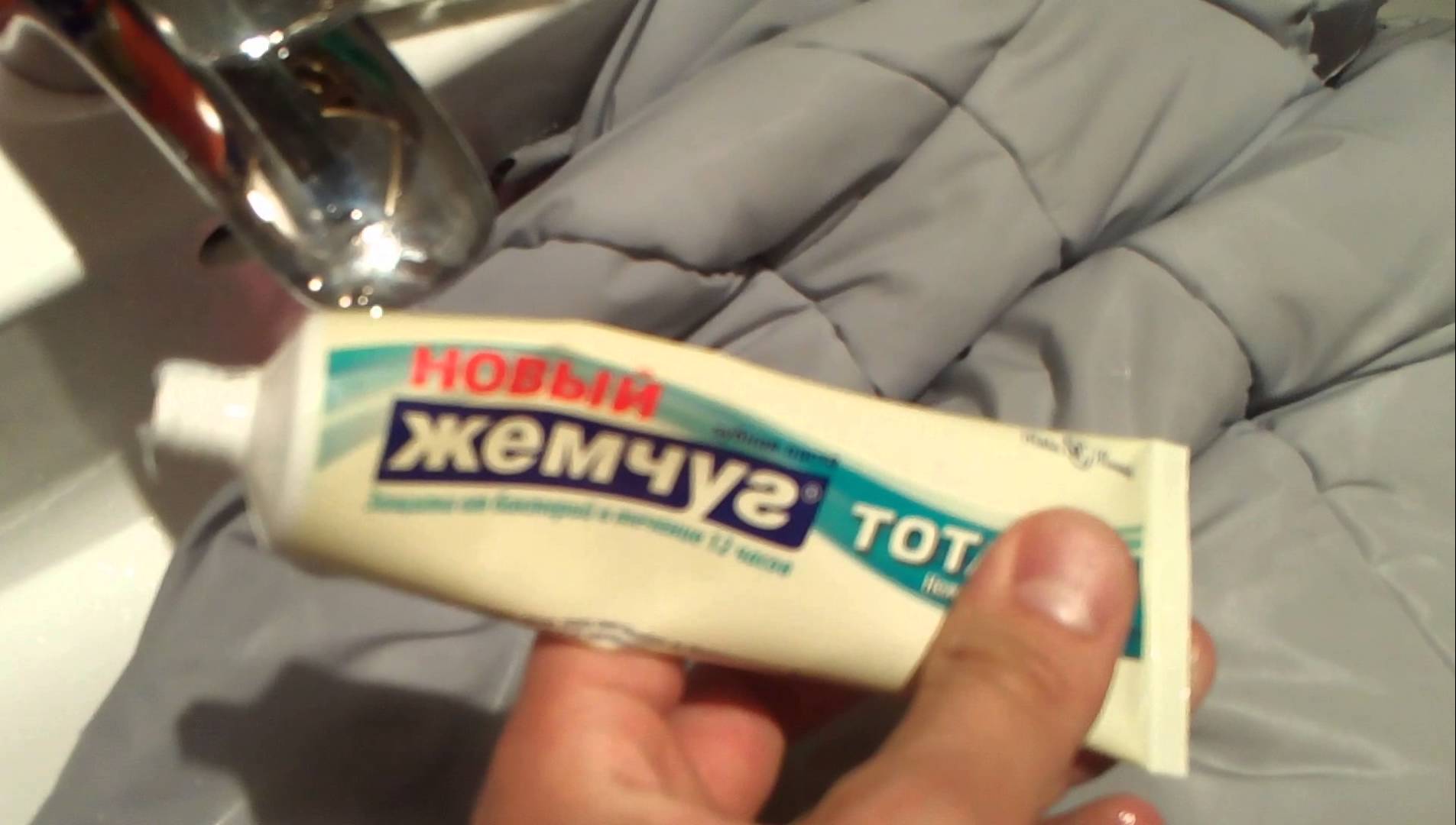Methods for removing bituminous spots
In order to remove traces of bitumen, you can choose professional or folk remedies. We must not forget that it is better to remove the mastic immediately after contamination, so that the availability of the cleaner plays an important role.
It is equally important to consider what material the soiled thing is made of, since different products are suitable for different fabrics.
Professional remedies
Bitumen removers are often designed for motorists and are ideal for removing dirt from the paintwork of cars and their chrome parts. The advantage of cleaners is that they remove the bituminous stain without damaging the substrate. As a rule, they are available in the form of convenient spray cans. The agent is sprayed onto the stained area, wait a while, wash off the remnants of dirt. Professional aerosols are also suitable for removing bitumen from clothing.
Super DeGreaser
The cleaner will effectively cope with drops of bitumen not only on the elements of the car body, but also on the fabric. It is easier to remove dirt from natural materials such as cotton and calico, as well as from the denim from which jeans are made. The product is applied to the stained area for 5 minutes, after softening, the mastic is removed with a cloth or cotton swab and the thing is washed with a detergent.
Tar remover
It will help remove oil and bitumen stains and remove stubborn dirt. It is applied to the affected area for a few minutes, after exposure is erased. If the bitumen layer is thick or the stain is old, several treatments may be required. After removing dirt from the fabric, wash in the usual way.
"Eltrans"
Eltrans bitumen stain cleaner is produced in the form of an aerosol and is designed to remove traces of bitumen, tar, technical fluids from vehicle elements, but it is also used for other surfaces. To clean the contamination, the balloon is shaken and sprayed onto the area, left for 5-10 minutes, and then cleaned with a sponge.
How to apply
Protect your hands with gloves before using professional cleaning products. It is advisable to check the effect of the substance on an inconspicuous area so as not to spoil the thing. When using the products, you should carefully study the instructions on the packaging and follow them.
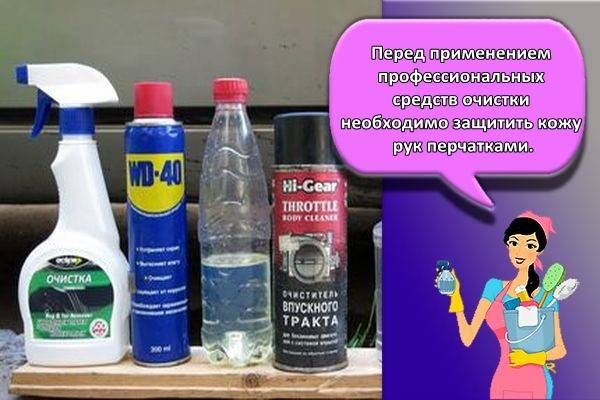
Self-preparation of the solution
To eliminate bituminous contamination, you can prepare a mixture of starch, turpentine and white clay, taken in equal parts, one teaspoon of each component is enough. The solution is thoroughly mixed to a pasty state, adding a few drops of ammonia, and applied to the contamination. After the mixture has dried, it is removed with a brush, the thing is washed by hand or in a machine. A yellowish trace may be visible on the affected area, in which case it must be wiped with hydrogen peroxide.
Folk methods
You should try to remove bitumen as soon as possible, before it has time to eat into the fabric, and if there are no professional cleaners at hand, you can resort to the help of improvised properties. They are also useful for removing dirt from materials that cannot withstand the effects of solvents, such as synthetic fabrics.
Butter
A little butter is rubbed into the bituminous stain. The contaminated area brightens, while the oil turns black. The soiled fabric is rubbed with oil until the bitumen disappears completely. Then the item is washed with detergent.
Fir oil
The tool is well suited for removing bitumen from fabrics, even delicate ones. To do this, two cotton pads are moistened in oil and pressed against the material from both sides.After the contamination has gone away, the thing must be washed to remove the greasy residue from the fir oil.
Coca Cola
Coca-Cola is added to the water along with the detergent and the item is washed in the usual way. The stain disappears during the washing process.
Soda solution
Soda helps to wipe off many types of contaminants, including from bitumen. To clean stained clothes, dissolve 30 grams of caustic soda in a liter of water and soak the clothes in the product for a couple of hours. After that, the thing needs to be washed and rinsed well.
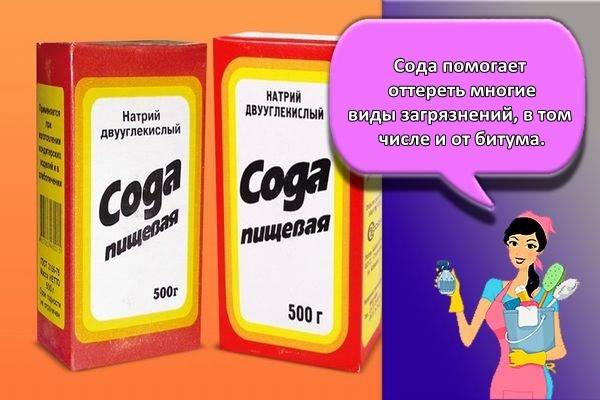
How to remove bitumen stains from a car
On cars, bitumen splashes and droplets appear on the lower fenders, arches and front bumpers (a gift from the vehicle in front). Undesirable resinous tuning is found when it has already petrified and has become as strong as a metal corner for a tile, except that it shines less.
Bitumen is resistant to water of any temperature and most aqueous solvents. They are well removed with benzene, carbon disulfide and other organic solvents - turpentine, white spirit, etc. Before removing bitumen stains from a car, you need to make sure that the car enamel is resistant to the selected solvent. It is best to buy a special "Bitumen Stains Cleaner" or Profam 3000, but always branded bottles. These compounds do not leave marks on the lacquered surfaces of the fenders and on the chrome hoods.
If a special cleaner is not available, use kerosene or diesel fuel to remove bitumen from your car, they do not interact as actively with car enamel as standard gasoline. Fine and rare bituminous splashes can be removed with ordinary butter if you are patient. The place where the bituminous spot was located will need to be polished, otherwise its shade will be discordant with the main color of the car paint.
How can bitumen be removed from shoes?
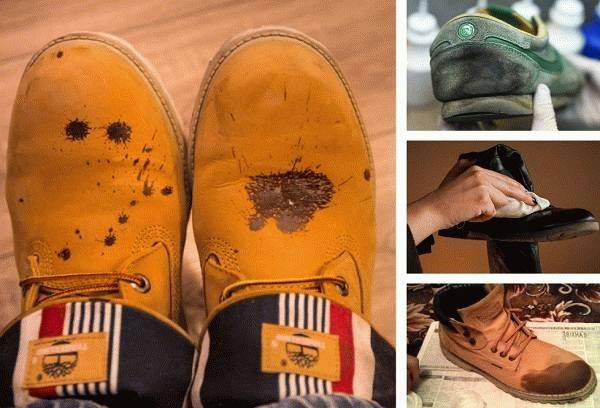
If the products are not made of fabric, then all the listed types of solvents can be tested on them, starting from the softest and moving on to the more aggressive ones. It should be remembered that genuine leather tolerates such cleaning better than a substitute. But in the case of suede, everything is quite complicated. Even if the stain can be completely removed, the shoe will most likely have to be completely repainted black.
If bitumen has to be removed from carpet or flooring, a wide variety of solvents are again used. Unfortunately, such manipulations often lead to permanent changes in the color and texture of the material.
Cotton and linen
If you need to wash tar from thick cotton clothes, this recipe will help out: mix turpentine, white clay and starch taken in equal parts. Apply to the contaminated area and wait until a crust forms, then brush off with a stiff brush.
What else can you clean the tar if it gets on cotton or linen? Gasoline will help in this matter. It is used as follows: a cloth with a stain is stretched over an empty container, spilled with gasoline, left for 2 - 3 hours, rinsed, washed with powder.
Treatment with solvents gives good results, and natural fabrics withstand both the influence of solvents based on petroleum products and acetone, although the latter copes worse with fuel oil, tar and bitumen.
We clean the stains with improvised means
Did you accidentally put one stain and don't want to buy a whole package of a ready-made product because of one such mark on your clothes? Then you can try to remove the dirt with home remedies. We will show you how to remove such marks.
If the item is made of linen or cotton fabric, first try to wash the stain like this: wipe it with a swab or cotton pad dipped in ammonia.

- Regular butter copes quite effectively with tar stains.Apply a small amount of it to the area where there is a residue of tar, and gently wipe the stain with a sponge or clean cloth. Do this until it disappears completely. The oil will darken over time and the stain will disappear. Then the item can be washed as usual.
- Sunflower oil and fir oil can help with the solution of such a problem. To do this, put a small amount of such oil on a cotton pad and gently wipe the stain. This must be done on both sides of the product with wiping movements in one direction. Then we remove the remaining greasy stains from the clothes. They are simply washed off with a dish detergent. Treat oil stains with this product, rub, leave for half an hour and wash the product.
- You can remove tar stains from clothes in another very unusual, but very effective way. Just add about 1 cup of Coca-Cola to the powder during the wash - the tar is perfectly cleaned. It sounds strange, but it always helps. True, this method is only suitable when the stain is small and completely fresh.
- It is good to remove such stains with caustic soda. Take 1 cup of this baking soda, dilute it in about 10 liters of warm water. Leave the item in a dish with this solution for 1-2 hours, then wash.
- You can remove the stain with a mixture of baking soda, turpentine, starch and ammonia. All components, except alcohol, are mixed in glassware in equal proportions, so much alcohol is added so that the mixture resembles thick sour cream in consistency. Apply the resulting mixture to the contaminated area and leave to dry completely. Remove the rest of the mixture, wash the thing.
If there are such stains on clothes a lot, for example, if the clothes are working, then the thing is left for two to three hours in gasoline, then wrung out, rinsed several times in running water and washed in a machine in an accessible mode. Gasoline must be cleaned!
The main rule for removing bituminous spots
The key to successfully combating any pollution is understanding its nature. Therefore, before deciding how to wash the bitumen, it is necessary to figure out what kind of substance it is. So, bitumen is a product of the distillation of oil, or, to put it quite simply, that part of the oil that remains after the removal of light fractions from it. Accordingly, only substances obtained by oil distillation can dissolve it.
Conventional chemical solvents based on acetone with bitumen will not cope due to the inappropriate chemical composition. The basis of oil and any products obtained from it is high molecular weight carbohydrates. And in the composition of acetone there are oxygen groups that prevent the agent from breaking down these same carbohydrates. So, with the help of acetone-containing solvents, you can, at best, slightly lighten the bituminous stain, and at worst, spread it over an even larger area of the soiled thing.
Why not wash bitumen from clothes and shoes
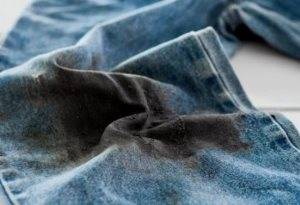 In many household forums, you can find advice on how to remove bituminous stains with the help of improvised means. They offer nail polish remover, ethyl alcohol, and even Coca-Cola. If you carefully read the previous section, then you already understand that there will be no sense from such "solvents".
In many household forums, you can find advice on how to remove bituminous stains with the help of improvised means. They offer nail polish remover, ethyl alcohol, and even Coca-Cola. If you carefully read the previous section, then you already understand that there will be no sense from such "solvents".
Cleaning products are also offered by household / construction / car stores. Most often it is advised to use WD-40, which is used as a water repellent and lubricant. Due to the presence of white spirit in the composition, this agent dissolves bitumen stains relatively well. But, since mineral oil is present in large quantities among the components of WD-40, it is still not worth using it for cleaning clothes. The oil will quickly be absorbed into the fabric, and you will have to remove the grease stain additionally. But if you are looking for how to wash bitumen from shoes made of leather or leatherette, this composition is quite suitable. For the fabric, it is better to use pure white spirit.
How to wash a bituminous stain: step by step instructions
Bituminous contamination rarely looks like a regular stain. Most often it is a blotch of thick, viscous resin. Therefore, the first step in cleaning is to remove as much bitumen as possible mechanically.
First, cut off the thick bitumen layer with a sharp knife. A clerical or dummy knife is best, or you can use a regular razor blade.
Be careful not to damage the fibers of the fabric / the surface of the skin to which the mastic has adhered
There is no need to scrape off the bituminous blotch. First, you have a good chance of simply smearing it over the base, thereby increasing the area of the stain. Secondly, if the bitumen is already well adhered to the surface, the blotch can tear a piece of fabric out of it. It is especially dangerous to scrape off the mastic from the varnished shoes - damage to the varnish is almost inevitable.
Sometimes, for ease of cutting bitumen, it is advised to put the thing soiled with it in the freezer for a while. It is assumed that a drop of bitumen, like a chewing gum, will freeze and lag behind the fabric itself. In practice, this turns into the fact that the mastic is absorbed even more into the base, and it becomes almost impossible to remove it.
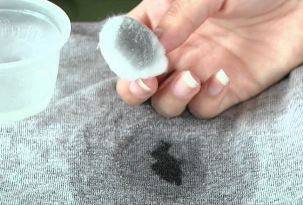 When the bulk of the bitumen has been removed, roll up a waste cotton rag and place it under the stain. Make sure that the soiled fabric is well stretched over the roller. Then start dripping onto the dirt with your chosen solvent - gasoline, kerosene, etc. The bitumen will dissolve and be absorbed into the substrate. Turn the roller over with the clean side as it gets dirty.
When the bulk of the bitumen has been removed, roll up a waste cotton rag and place it under the stain. Make sure that the soiled fabric is well stretched over the roller. Then start dripping onto the dirt with your chosen solvent - gasoline, kerosene, etc. The bitumen will dissolve and be absorbed into the substrate. Turn the roller over with the clean side as it gets dirty.
Continue these procedures until the stain is gone. Then wash the item with a good stain remover (Vanish has compiled the most flattering recommendations for this case). If yellowish streaks remain on the fabric, remove them with hydrogen peroxide.
What you do not need to use to remove a bituminous stain
Bitumen cannot be washed off with plain water. Washing can only help with fresh dirt, but it is imperative that you add an oxygen stain remover or pre-soak the item in a prepared composition.
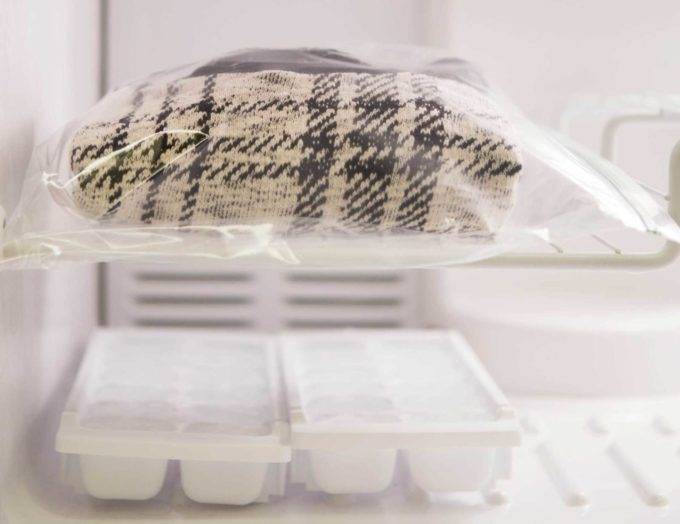
Do not freeze a thing soiled in tar. This resin strongly eats into the fibers, after which it is quite difficult and not always successful to remove it.
If a thing made of synthetics or silk is dirty, it is not recommended to use strong solvents, as the material may disintegrate. If only such means are at hand, they are first tried on an inconspicuous part of the product. It can only be applied to the area of the stain.
Tar stain: first aid methods
As with any stain, we do not immediately notice a tar mark on clothes. But if you managed to detect the moment of contamination, remember the main thing - do not try to rub the tar trail. So you only rub it deeper into the fibers of the fabric, to which it will firmly adhere.
If a large drop of this substance gets on your clothes, try to gently remove the top layer with a paper towel. Do not wait until the tar hardens; it will not work to knock it off without harm to the fabric. Try to remove the main volume, as if by pinching small pieces from it. If you notice contamination when the drop has hardened, try carefully cutting off the top with a sharp utility knife.
How to remove tar stain by industrial means
 Asphalt stains are most often encountered by builders and motorists. For them, many special solvent liquids have been invented, which help to quickly remove contamination from various surfaces. The following compositions are recognized as the most effective for processing clothes:
Asphalt stains are most often encountered by builders and motorists. For them, many special solvent liquids have been invented, which help to quickly remove contamination from various surfaces. The following compositions are recognized as the most effective for processing clothes:
- Belgian Tar Remover;
- English "Super DeGreaser";
- American - TurtleWax or ArmorAll;
- Russian bitumen stain remover "Eltrans".
These funds can be purchased at home improvement stores or large hardware stores.They work well on fabrics. Other compounds that motorists often recommend, of course, can help solve the problem of how to clean tar from tires or car body. Still, it is rather risky to use them for clothes - the cleaner can eat the paint, and even damage the fibers of synthetic fabrics. However, if you have planted a tar stain on the sole of your shoes, it is quite possible to use bitumen thinners from the car market. The most effective means are:
- Buster bug (Hi-Gear);
- liquid WD-40;
- Tar-Pitch;
- Profoam 3000.
How to clean tar with gasoline
In addition to industrial remedies, there are a couple of effective folk methods for dealing with tar stains. One of them is the treatment of pollution with gasoline. Since tar is a refined product, it is most logical to use agents with the same base to dissolve it. Just do not rush to drain the gasoline from the car tank, it will not work. Buy gasoline "Galosha" in the household or construction department of the supermarket, or, in extreme cases, gasoline for refueling lighters. These compounds are free of impurities, so they will not be able to harm clothes.
In addition to gasoline, you will need a piece of unnecessary cloth and a cotton pad. Roll the fabric in several layers and place it under the soiled area of clothing. Soak a cotton pad in gasoline, and start blotting the stain with it, moving from the edges to the center. The gasoline will dissolve the sludge and drain with it through the fibers of the clothing onto the fabric backing. The latter, as it gets dirty, will need to be changed or turned over with its clean side.
When the tar stain has disappeared, the treated area will need to be washed with laundry soap or dishwashing liquid to remove the gasoline mark. After that, wash the item as usual. Be sure to add fabric softener to ensure you get rid of the gasoline smell.
We remove tar from clothes with oil
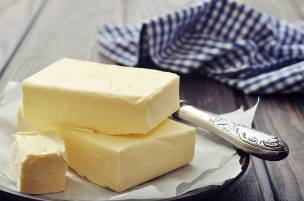 Due to the high content of resins and paraffins in the tar, it dissolves quite easily with oils. Even the usual creamy one will do, only it will take quite a lot to remove the stain. The oil should not be taken from the freezer, but slightly melted to a soft state. Apply a small amount to the stained area and rub it as if you were washing a garment. After a while, you will notice that the oil layer has darkened. Wipe it off with a paper towel, and use it to blot well the stain, trying to collect as much of the grease mixed with tar. Repeat the procedure until the tar residue is completely dissolved.
Due to the high content of resins and paraffins in the tar, it dissolves quite easily with oils. Even the usual creamy one will do, only it will take quite a lot to remove the stain. The oil should not be taken from the freezer, but slightly melted to a soft state. Apply a small amount to the stained area and rub it as if you were washing a garment. After a while, you will notice that the oil layer has darkened. Wipe it off with a paper towel, and use it to blot well the stain, trying to collect as much of the grease mixed with tar. Repeat the procedure until the tar residue is completely dissolved.
A more effective way to clean tar is to use fir oil. It will work not only due to its oil base, but also due to essential components that will accelerate the dissolution of pollution. In addition, the clothes will acquire a pleasant pine scent. Treat the stain with fir oil in the same way as with gasoline or white spirit. And at the end, wash the item immediately in hot water and soap to remove the greasy stain.
How to remove tar from white fabric
This method of removing tar stains is suitable only for light-colored items made from natural fabrics - cotton, linen, jeans, etc. Soak them before washing in a solution of caustic soda, made up in the proportion: 250 grams of baking soda per 10 liters of water. After a couple of hours of soaking, the stain will disappear, and the overall tone of things will noticeably brighten.
Effective ways to remove tar from clothing
More often people involved in the construction of various objects and roads have to deal with traces of bitumen or tar. There are times when ordinary people, due to inattention, plant a sticky stain from an oil product on their clothes.
In order for work and everyday things to always look decent, you need to know how to clean tar from clothes? Let's look at which compounds are most effective in dealing with these contaminants.
How can you remove tar
People who come into contact with tar are advised to use professional household cleaning products to clean their clothes. These can be “SuperDeGreaser” or “Eltrans” preparations designed to remove contaminants from bitumen.
The use of industrial formulations assumes compliance with safety measures and certain rules.
Before using any cleaning agent, carefully read the instructions for use and the manufacturer's recommendations.
Pay attention to such a parameter as the expiration date.
To avoid unexpected consequences when using manufactured products, do not perform cleaning without personal protective equipment.
Follow strictly the instructions on the package, pre-test the drug in an inconspicuous area to prevent negative effects on the material .. People can cope with random traces of tar, and folk methods
People can cope with accidental traces of tar with folk methods.
Cleaning tanks from oil products
Cleaning the tanks from oil products is not an easy job that requires the participation of professionals. It is no secret that the quality of a product directly depends on the quality of the container in which it is stored. Therefore, it is necessary to carry out its thorough cleaning in a timely manner. The cleaned container will be usable throughout the entire shelf life.
The containers should be inspected periodically, identifying possible defects and, if necessary, repaired. With regular inspections, the risk of losing gasoline and other fuels is significantly reduced. Consequently, the environment is not exposed to undesirable influences.
For fuel oil, oil, motor fuels and other similar oil products, reinforced concrete and metal tanks are used. In addition to periodic cleaning, cleaning of these tanks should also take place before replacing one oil product with another.
As a result of any cleaning, the container is freed from:
- natural deposits;
- water and rust;
- various viscous sediments;
- etc.
In this case, the operations are carried out in the following sequence. First, the rest of the oil product is removed, degassing is carried out. Then the container is rinsed under pressure with hot water. For this, a detergent is used. This operation is also called steaming. The hot water rinse is repeated two times. At the end of the work, the bottom is thoroughly dried and wiped with a rag.
Numerous washes and other cleaning agents are pleased to provide you with the company - LLC "Docker Chemical GMbH Rus". In our product line you can see both professional chemistry for solving especially difficult tasks, as well as a range of products for cleaning various surfaces.
The variety of products offered by our specialists will allow everyone to find exactly what he needs at the moment. We care about each of our clients and strive to satisfy any of his needs.
Don't waste your time, become our client today! Don't miss this opportunity!
Features of removing stains
Store funds
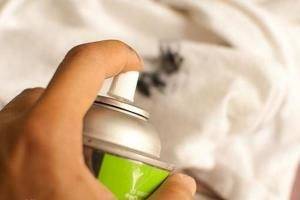 There are special preparations for removing traces of resin.
There are special preparations for removing traces of resin.
In the departments of hardware stores, you can purchase a chemical designed specifically to remove tar stains from various surfaces. These are rather highly concentrated products, therefore, before cleaning, you should definitely read the instructions for use to remove dirt directly from clothing, check the expiration date of the drug. When using, protect yourself with protective equipment (gloves on hands and a face tight bandage). Do not neglect the recommendations regarding the dosage of the substance, the abundance of chemistry can completely ruin the thing. List of the most effective remedies:
- "Tar Remover" - manufacturer Belgium;
- Super DeGreaser - Made in the UK;
- Eltrans is a Russian production.
What else can you withdraw?
If a person accidentally gets dirty in tar and there are no special preparations for removing stains of this specificity, you should not run to the shops in search of a stain remover. The time spent will only complicate the task, as the contamination will dry out, the oily base of the substance will penetrate the fabric fibers and the chances of successful cleaning will decrease. In such cases, you can try to remove tar with the help of available tools that can be found in every home.
Sweet soda
 A well-known drink is often used as an effective stain remover.
A well-known drink is often used as an effective stain remover.
When removing tar stains from clothing, use Coca-Cola. Application: clean the dirt with a sharp knife, pour a generous amount of drink on the divorce area. The next elimination step will be to prepare a sweet wash solution. Add the same amount of soda to 1 liter of warm water and soak the soiled clothes in it for 30-40 minutes. After the expiration of the time, wash the item in the usual way with the use of powder.
Baking soda
If white products are stained in tar, you can try to cleanse the pollution with a soda suspension, which is prepared as follows: 4 tbsp. l of soda powder mixed with warm water so that a pasty mixture is formed. Apply the resulting gruel to the stain and leave for 20-30 minutes until completely dry. Then wash the thing in soapy water. To improve the effect, soda can be diluted with 6% vinegar.
Starch cleaner
If the stain is very fresh and was detected immediately after it started, you can use a quick and effective stain remover made from potato starch. Preparation and use: mix equal parts of the potato ingredient and table salt, apply the mixture to stain and gently rub the stained area, repeat the manipulation until it disappears completely.
Oil + detergent
 The dairy product is applied directly to the dirt.
The dairy product is applied directly to the dirt.
Washing with butter will help get rid of greasy dirt. Mode of application:
- Apply a melted, soft product directly to the stain and rub thoroughly as in a wash. In the process, it will become noticeable how the oil darkens, absorbing the remnants of tar, and dark stains on clothes gradually disappear. Rub until the contamination disappears completely.
- Treat greasy oil residues with dishwashing detergent or laundry soap.
- Wash the item in a washing machine or by hand washing.
Fir oil
You can clean tar from trousers or other clothing using fir oil purchased from a pharmacy. Apply the product to a cotton swab and place it on the wrong side of the garment, right under the center of the stain. Soak the other disc with the solution and wash it off the dirt from the front side of the cloth. Handle the stained part of the garment with gentle movements, starting at the edges and moving towards the center of the tar track. After the procedure, wash the item using powder.
Other recipes
If a large number of stains of different sizes are observed on the clothes, the clothes can be soaked in gasoline and left for 2-3 hours. After the time has elapsed, wash in a machine at a temperature of 90 degrees using the powder. This is a rather crude method of removing contaminants, so it is more suitable for cleaning the robes of road repair workers, builders, roofers and people of other specialties who often have contact with oil refined products.
And also many people use acetone in the fight against such pollution, which must be used carefully, as it can ruin both the color and texture of the fabric.

